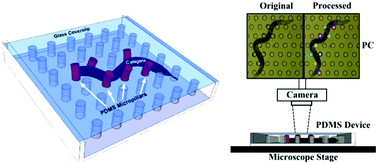On-chip analysis of C. elegans muscular forces and locomotion patterns in microstructured environments†
Abstract
The understanding of force interplays between an organism and its environment is imperative in biological processes. Noticeably scarce from the study of C. elegans locomotion is the measurement of the nematode locomotion forces together with other important locomotive metrics. To bridge the current gap, we present the investigation of C. elegans muscular forces and locomotion metrics (speed, amplitude and wavelength) in one single assay. This assay uses polydimethylsiloxane (PDMS) micropillars as force sensing elements and, by variation of the pillar arrangement, introduces microstructure. To show the usefulness of the assay, twelve wild-type C. elegans sample worms were tested to obtain a total of 4665 data points. The experimental results lead to several key findings. These include: (1) maximum force is exerted when the pillar is in contact with the middle part of the worm body, (2) C. elegans locomotion forces are highly dependent on the structure of the surrounding environment, (3) the worms' undulation frequency and locomotion speed increases steadily from the narrow spacing of ‘honeycomb’ design to the wider spacing of ‘lattice’ pillar arrangement, and (4) C. elegans maintained their natural sinusoidal movement in the microstructured device, despite the existence of PDMS micropillars. The assay presented here focuses on wild type C. elegans, but the method can be easily applied to its mutants and other organisms. In addition, we also show that, by inverting the measurement device, worm locomotion behaviour can be studied in various substrate environments normally unconducive to flexible pillar fabrication. The quantitative measurements demonstrated in this work further improve the understanding of C. elegans mechanosensation and locomotion.


 Please wait while we load your content...
Please wait while we load your content...